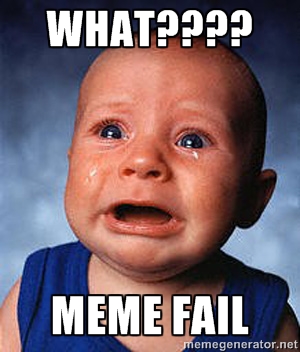May 14, 2014: Ah, memes. Social media lets anyone create a clever catchphrase, idea, or image and endow it with the potential to become viral, spreading across social networks like wildfire. Anyone who can create a clever graphic or create a provocative hashtag can now have this/her brilliant idea take the social media world by storm, creating recognition and boosting the brand.
But then, we have unfortunate cases like Kony 2012, the Breast Cancer Awareness Pink Bra campaign, and Jimmy Kimmel’s Twerk Fail.
The Internet is strewn with the wreckage of folks trying to show how clever they are and failing miserably. Aside from the schadenfreude that we all experience when a meme fails, it’s possible to benefit from the takeaways that each particular disaster reveals.
Why Memes Matter
The creation and execution of viral memes is becoming more and more important in marketing. Once regarded as a guerilla technique, even large brands now regularly create memes to assist their own big dollar media campaigns. A quintessential example is the #winteriscoming hashtag for the HBO hit series “Game of Thrones.” Another excellent example is how President Obama worked with Zack Galifianakis on their Between Two Ferns spot for Healthcare.gov.
However, it’s very easy to screw these up. Often, viral memes become twisted, corrupted, are hijacked, or are just simply in bad taste or ill-considered. Brands can stumble while attempting to show how hip and funny they are; the result is often quite the opposite. Even brands that do everything right sometimes have their viral attempts hijacked or just simply warped.
In order not to fail, a meme must be these things:
 A meme must be relevant. This seems like a no brainer, but if a meme does not have a direct “relevance hook,” then it will be ignored as — well, irrelevant. Not only must a meme be clever and funny; it needs to be something that *directly relates* to the life and experiences of the meme’s target audience.
A meme must be relevant. This seems like a no brainer, but if a meme does not have a direct “relevance hook,” then it will be ignored as — well, irrelevant. Not only must a meme be clever and funny; it needs to be something that *directly relates* to the life and experiences of the meme’s target audience.
A meme must be authentic. Internet denizens can smell fakery and sales pitches from afar. Attempts to hijack popular hashtags or memes (such as Kia’s disastrous meme campaign) smack of desperation and a refusal to pay for good original content. Inauthentic and cheap are horrible when experienced separately, and disastrous when put together.
A meme must actually be funny or interesting. It’s unfortunate that some marketers simply look at memes as a cheap way to generate content. Poor jokes are not a substitution for actual content that requires effort and skill to develop. There’s a big difference between easily copied cat memes and the brilliant work done by Jimmy Kimmel and the staff of Cracked.com. Working professional editorial talent into your marketing plans is a must.
A meme must be kind. Mean-spirited memes have a way of backfiring on companies, as demonstrated by Black Milk’s recent failure during Star Wars day. Fans are more forgiving if the actual meme itself is positive, whereas backlash against mean spirited memes can be tremendous. Further, if the meme is remixed and twisted into something awful, a good-spirited meme differentiates itself from such awful content.
A meme can’t be stupid or in poor taste. Memes that are clueless, inane, or thoughtless will be remixed and abused without mercy. There are entire websites devoted to failed memes and how they get remixed by a ruthless Internet. This collection of bad memes includes horrid disaster-related memes and anything that uses a tragedy to make a direct sales pitch, such as Kenneth Cole using the Arab Spring riots to hawk a sale.
Memes can be terrific tools to raise awareness for your brand, but they must be executed with care and authenticity. Share with us your failed meme horror stories.
Have a question about Social Media? Contact us.
- 10 Mistakes to Avoid When Using QR Codes for Marketing - September 20, 2023
- Kevin Lee on How AI Changes the SEO Landscape - August 31, 2023
- The Power of Compound Marketing: Kevin Lee Presents @ 1MediaWorld 2023 Global Conference - March 7, 2023

